
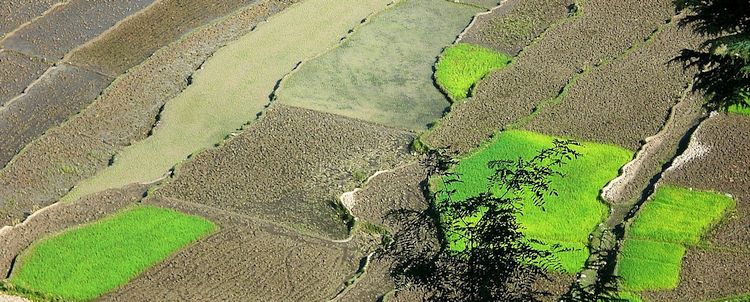
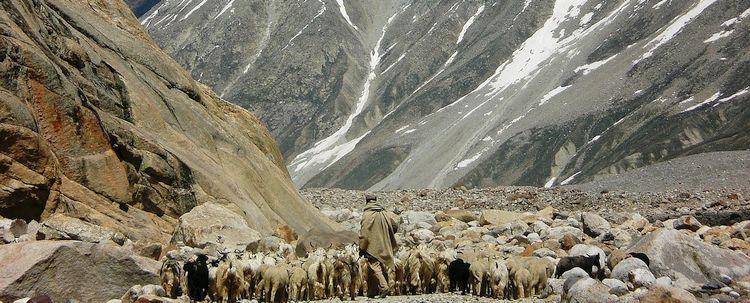
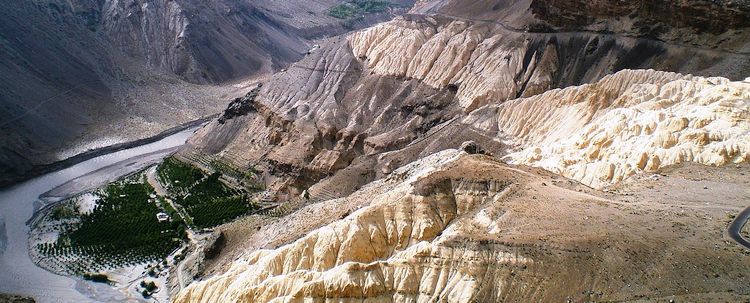
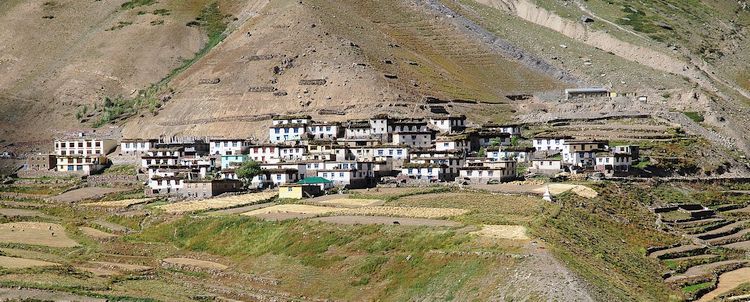
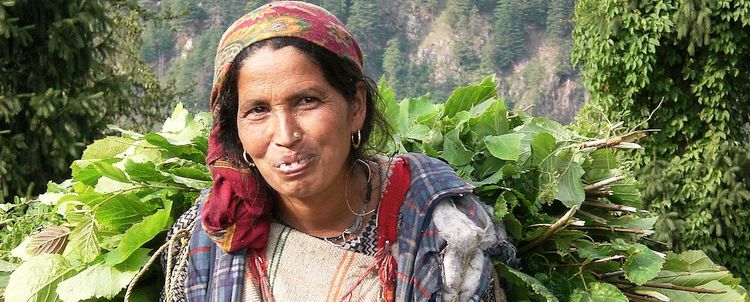
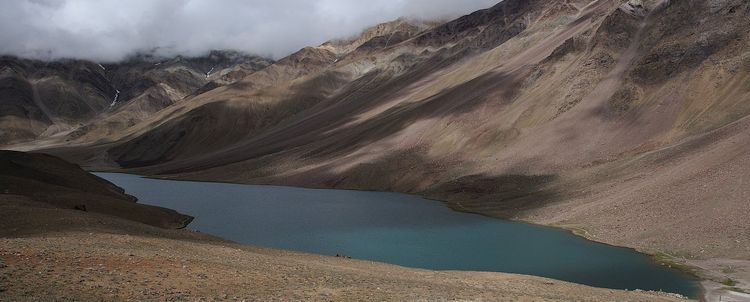




Himachal Pradesh –
Contrast Program between Fertile Valleys and Jagged Peaks
Best Travel Time | Himachal Pradesh in Brief | Peoples and Religions | Food | Flora and Fauna | National Parks and Nature Reserves | Mountain scenery and Trekking | History | Economy | Festive Calendar
Himachal Pradesh, located far amidst the Himalayas in northern India, amazes with its exotic valleys, fragrant orchards, snowy mountain peaks and rushing brooks. The majority of this mountainous Indian state is heavily forested, and reveals at first glance, why some regions of this part of the world are often called "the Indian Switzerland". The beautiful nature can be explored in two national parks and 32 conservation areas for flora and fauna, and holds mountain lakes with a mystical touch and slopes strewn with boulders, with secluded mountain huts for travelers as a gem of landscape diversity against white mountaintops.
On an area of around 56,000 km² - which is a little larger than the German state of Lower Saxony and nearly one and a half times as big as Switzerland - in the middle of the last century 31 principalities were joined together, what may explain the wide diversity of cultures of the native hill tribes and their languages. Above all, it is also the peaceful openness of this Indian state, which offered the in 1959 exiled Tibetan government refuge, and until today grant to it and its Dalai Lama, in the city of Dharamsala, the possibility to live and have their government. This of course also revived Buddhist traditions in the country, and enriched language, culture and architecture, especially in the scenically rather barren district of Spiti.
Here in Spiti, but also in some of the neighboring districts, the colorful prayer flags and ornate temples of Buddhists repeatedly surprise the eye, as well as the traditional, brightly orange robed monks in the barren mountains. Nevertheless, especially in the southern regions of the state, the major part of the population of Himachal Pradesh is of Hindu faith, and the temples carved out of wood, and the lavishly decorated shrines are in no way inferior to those of their brothers of Buddhist faith, inviting pilgrims and travelers to linger, and to admire the elaborately designed buildings.
Likewise one should visit the palaces of the former rajas (the princes) in the wild mountain landscape, some of which were partially restored with affection, and tell the story of ancient India. Meet with us the many Hindu and Buddhist cultures of the indigenous hill tribes, and explore the mountain scenery from the lush fertile monsoon area to the dry stone deserts on the border with Tibet.
Best Travel Time
For the districts Kullu, Manali, Shimla, Palampur and Dharamsala: March to September.
For Spiti, Lahaul & Kinnaur: From July to October.
The monsoon starts in late June. In July and August the heavy rainfall cause south of Spiti and Kinnaur erosion and landslides.
The best time for trekking is from May to end of October.
Himachal Pradesh in Brief
| Location | In the extreme northwest of India, bordering with Tibet in the east, with the Indian state of Punjab in the south west, with Haryana and Uttar Pradesh in the south, and Uttarakhand in the southeast, as well as with Ladakh / Jammu and Kashmir in the north and northwest. |
| Area | 55.673 km² |
| Population | 6.864.602/ 123 pro km² (2011) |
| Capital | Shimla |
| Districts | 12 Districts: Bilaspur, Chamba, Hamirpur, Kangra, Kinnaur, Kullu, Lahaul and Spiti, Mandi, Sirmaur, Shimla, Solan and Una. |
| Topography | Himachal Pradesh is situated in the Himalayas at an altitude of 350 m above sea level to 6975 above sea level, and continuously rises from west to east, as well as from south to north. The state begins on the fringes of the northern Indian lowlands, and extends across the Shivalik mountains, and the valleys which are green in the monsoon area, between the first high mountain ranges, to regions that geographically belong to Tibet (Spiti, upper Lahaul and upper Kinnaur). The border areas in the north are dominated by high passes, which are covered with snow from mid-October to mid-July, the permanent snowline is at 5000 m above sea level. The rivers Chenab, Ravi, Bea, Sutlej and Yamuna traverse the region, and are flowing to the Indus and the Ganges. |
| Vegetation | From about 450 to 900 m above sea level prevails a subtropical vegetation with rain forests made of fig trees, teak and bamboo. Thereafter 900-1800 m above sea level is the climate temperate, and fir trees, Himalayan cedar Cedrus deodara, oaks and rhododendron make the tree population. From 1900 to 2400 m above sea level finally it is cooler, the woods are thinner and are made of chestnut, oak, an increasing number of birch trees and a few coniferous trees. The height between 2400-4800 meters above sea level finally is cold and alpine, the woods withdraw and the vegetation is lower, here juniper is widespread. The tree line is at about 3300 m above sea level. Overall, about 60% of the region is covered with by vast, intact forests. |
| Wildlife | Similarly broad as the flora is also the fauna in Himachal Pradesh: more than 30 species of mammals, 200 species of birds, reptiles, amphibians and countless insects live here. Rare anmals are surely the snow leopard, the dzu-the (the Himalayan brown bear Ursus arctos isabellinus), the blue sheep and the Himalayan thar (a species of goat). Ornithologists are pleased about sightings of various woodpeckers and finches, the Himalayan Monal (Lophophorus impejanus) and also the enthusiasts for exotic butterflies really will really be dazzled. |
| Climate | The year is divided into 3 seasons: summer (warm) March to June; Monsoon (rainy and warm): July to September; Winter (cold, especially at night and early in the morning): October to February. Because of the extreme height differences, the state has subtropical to subarctic climate zones. |
| Temperatures | In the lower regions from -5 ° C in December to 35 ° C in June. The central regions have temperatures between 5 ° C and 25 ° C in the course of the year, in the high altitudes permanently cooler. |
| Rainfall | From 500 to 2500 mm, depending on the altitude and the district, most of the precipitation falls during the monsoon season from late June to late August. |
| Languages | The national language is Hindi, Pahari (in various dialects) is also widespread, Punjabi and Nepali. In Spiti, Kinnaur and Lahaul a language is spoken which is related to the Tibetan, a dialect of Ladakhi. English as a foreign language is quite widespread. |
| Ethnicities | Approximately 90% are Brahmins, Rajputs, Kannets, Rathis and Kolis. Moreover Gaddis (traditional herders who migrate from the alpine pastures into the lower regions in winter), Kinnars, Gujjars (Buffalo nomads), Pangawals, Lahaulis and Tibetans. |
| Religions | Hindus (ca. 90 %) with Brahmins, Rajputs, Kannets, Rathis and Kolis. In Spiti and Lahaul: Tibetan Buddhism. In Thanedar and Kotgarh also Christianity, moreover Sikhs. |
| Economy | The economy is based mainly on tourism and apple cultivation. Kullu, Manali, Shimla, Palampur and Dharamshala are among the well-known tourist destinations. There are also two large cement factories and many service companies. The majority of the population lives from agriculture, especially from fruit production. |
| Getting there | Flight to Delhi in India. From there by train to Chandigarh. From Chandigarh by jeep to Himachal Pradesh. Shimla can be reached from Delhi by bus, train and by air. |
| Visa / Entry permit | For the entry to India, a visa is required. In addition, an entry permit for Spiti, this entry permit is being organized by us. For trekking in national parks, further authorizations are needed, which we are happy to organize |
| Vaccinations | We recommend, in addition to the usual ones, general vaccinations: vaccination against hepatitis A and B, typhoid, Japanese encephalitis, rabies and polio. |
Peoples and Religions
The people of Himachal Pradesh are deeply religious. Common is the in the south the Hinduism with still intact caste system, and the authentic Tibetan Buddhism in the sparsely populated northeast. One encounters a mixture of very different ethnic groups and communities. Approximately 93% of the total population are involved in agriculture. But the largest part of the country is owned by the higher Hindu castes like the Rajputs, Brahmins and Mahajans. There are also these castes, which dominate the economic and political life of the state. About a quarter of the population belong to the lower castes.
They are mainly craftsmen who quite naturally respect the members of the higher classes, something which is deeply rooted in their Hindu tradition. People possess a strong belief in the laws of karma - that good as well as the bad deeds are shaping the lives and are responsible for the next incarnation. The crime rate is correspondingly low, therefore the houses are, for example, generally not locked. Idle land in and around the villages is considered communal property (Shamlat). Many people in Himachal Pradesh, whether Hindus or Buddhists, find that nature has supernatural powers. The Himalayan mountains are gods; the forests, streams and rocks are alive with mystical powers.
Moreover people also worship local gods and protective entities, fairies and other supernatural beings. Animal sacrifices are an important part of religious rites, and are common at weddings, funerals or harvest festivals. The gods are summoned through dance and music. Guru Padmasambhava, who spread Buddhism in the 8th century in Tibet, lived for a time not far from Mandi, a central district of Himachal Pradesh. Here exists even today a temple dedicated to him. Lamas guide interested visitors in meditation and mantra recitation, they give spiritual advice, predict certain events and are practicing Tibetan healing . As diverse as the origin and the tradition of the people is of course the world of languages.
The official language is Hindi, which is spoken by the majority of the population. In addition, however, there are many additional dialectic mother tongues: within this a widespread language called Pahari, there are significantly different forms of Sanskrit. In Spiti, Kinnaur and Lahaul a language is spoken, which is related to Tibetan, a dialect of Ladakhi. One can usually also communicate in English.
Food
The popular recipes are influenced from Punjab and Tibet. In addition to the staple food rice, chicken curry, lentils and vegetable dishes with pickles belong to the daily food of the locals. Besides this, local specialties such as pateer, chouck, bhagjery and chutney are widely used. Popular are also Tibetan dishes such as momos (dumplings with meat or vegetable filling), chowmein (a noodle dish) or thukpa (noodle soup). There are also many more local specialties. In Spiti, roasted barley flour (tsampa) is the staple food. Also as a European traveler, one can eat deliciously in Himachal Pradesh, the selection offers something for every taste. It is important not to consume unpeeled or uncooked fruits and vegetables, because the widespread bacteria here are alien to our organism.
Flora and Fauna
The height differences in Himachal Pradesh are quite pronounced, and the topography brings forth a wide variety of vegetation and wildlife. Until about 900 m above sea level the climate is subtropical, and rainforests of teak, fig and especially bamboo cover the land. Particularly In these forests are many iridescent birds to be seen, especially woodpeckers and finches are common, and one can explore countless species. Similarly colored highlights are the many butterflies and moths, who have their homes here. A few large mammals such as elephants, rhinoes and leopards also live here - their populations are now unfortunately limited to designated sites. Only the monkeys make noise in a widespread way through the treetops.
In the medium altitude up to about 1800 m above sea level, the forest is changing, deciduous trees such as oak and chestnut trees are interspersed by Rhododendron, cedars and firs, so that mixed woodland predominates. Here lives the himalayan brown bear, a rare species, whose sighting will delight wildlife enthusiasts. The higher you go, the thinner the forests are, birches complement the trees or are increasingly standing alone in vast grasslands, which are permeated by alpine herbs and flowers. Here live mainly goats and sheep like the himalayan thar and blue sheep (Pseudois nayaur). On this level you can also find the rare Himalayan monal, and very rarely also the now nearly extinct snow leopard.
National Parks and Nature Reserves
The magnificent nature of Himachal Pradesh can be experienced in two national parks and 32 sanctuaries to experience the flora and fauna in its original beauty. Almost 70% of the land area is forested, of which about 90% is designated as protected area. Endangered animals like snow leopards, bearded vultures and the rare siberian ibex live here.
Pin-Valley-National Park:
The secluded Pin Valley, a side valley in the former Kingdom of Spiti, is since 1987 a National Park. It comprises several mountain ranges of the Himalayas from 3700 m to 6600 m. Above 5000 m, the National Park is covered with snow all year round. In the sparse vegetation are snow leopards, wolves, mountain goats, foxes, weasels, marmots and some other animals at home.
Great-Himalajan-National Park:
The area, to which the access is to the west, is surrounded on three sides by the Himalayas. Covering an area of 620 km² of snowcapped peaks, glaciers, river valleys, fields of flowers can be found, and dense forests where pine, cedar, oak as well bamboo are growing. To the abundant wildlife, belong among other mountain goats, sheep, wolves, macaques, leopards, brown and black bear, snow leopard and many species of birds.
Mountain scenery and Trekking
Those who want to do trekking on holiday are very well cared for in Himachal Pradesh, but also day hikes or slightly longer walks with a comfortable base are marvelously possible here, and allow a view of exotic landscapes and spectacular scenery with white mountain giants. Due to the variety of the landscape, the trekking routes are also ideal to be adapted to personal interests and capabilities.
| Physical challenge | Designation and territory of the trek | Maximum height | Duration | Type of accommodation | Information / Description |
|---|---|---|---|---|---|
| Hiking | |||||
| easy to moderate | Kinnaur Hikes & Treks | 2750 -3600 metres | 2 – 8 hours | Mountain cabin or comfortable safari tent | Discover the alpine flora of the Himalayas, the pine forests, glaciers, rivers and the remote villages and enjoy the fantastic mountain panorama. |
| TREKKING up to 4800 metres | |||||
| easy to moderate | Spiti Yak-Trekking amongst Asia's highest villages | 4500 metres | 2 - 3 days | homestay | Discover the Tibetan heritage in high-altitude villages and the world of the yak herders. |
| TREKKING up to 5600 metres | |||||
| moderate | Kinnaur to Spiti | 4870 metres | 5 days | tent | This trekking route leads you from the green, lush valleys in Kinnaur up to the barren desert of the Spiti valleys in the south of Ladakh. Meet some shepherds along the way and be surprised by the change of climate zones, by the diversity of the vegetation and the civilizations. |
| demanding | Kibber to Tsomoriri Spiti, Himachal & Ladakh | 5588 metres | 9 days | camp | Visit monasteries, remote villages and isolated mountain lakes, and enjoy Ladakh's spectacular scenery of the Himalayas. You will be crossing high mountain passes. Ideal from mid-August to late September. |
| MOUNTAINEERING above 5600 metres | |||||
| moderate | Mt. Kanamo/ Spiti | 5974 metres | 10 days | tent | Mount Kanamo is referred to by locals as "good omen" or simply as the "white lady", and is known among mountaineers as one of the peaks which are easier to climb. The north side is dominated by the Kanamo glacier, the south side has formed a scree slope with some larger boulders lying here and there. The southern mountain ridge of the "Dombachen crest", which connects the Kanamo with the Dombachen summit is surrounded by the "Kibber plateau", which is teeming with wildlife. Frequently one can see herds of up to 90 blue sheep. The Himalayan ibex is common in this region too, and there are sightings of Tibetan wolves and of the rare snow leopard. The peak of Mount Kanamo offers an incomparable view over the Tibetan high plateau and to the magnificent peak of the Cho Cho Kang Nilda |
History
From the earliest times onwards, the area of the present-day Himachal Pradesh was inhabited by tribes such as the Koilis, Halis, Dagis, Dasa and Kirats. They lived a rural life and had a fairly peaceful coexistence. In the year of 1009 BC then the Turkish commander Mahmud of Ghazni invaded the area, and plundered the temples in the north, many historical documents and works of art were destroyed and deported. In 1773 the Hindu Rajputs took over the rule, and Himachal Pradesh was given the favor of the royal patronage of the Mughals. But the attack of the Maharaja Ranjit Singh ended already in 1804 the rule of the Rajputs.
The Gurkhas, who have been immigrating from Nepal, conquered the area afterwards and caused again great destruction. During the early 19th century British India eventually expanded its influence and annexed after the Gurkha War of 1815-1816 parts of the district Shimla. The district of Kangra was annexed in 1846 after the Anglo-Sikh war by British India. After India's independence in 1947, the present-day Himachal became incorporated into the Punjab (then a province of British India), in 1948 a part became a centrally governed state territory of India. In the years until 1966 additional areas were added.
The remaining Himachal was consisting of princely states, which extended over six mountains until November 1966. Then it has been extended by incorporating mountain towns like Shimla, Kangra, Kullu, Lahaul and Spiti. Himachal Pradesh, with the capital Shimla, was eventually divided into 10 districts and incorporated into the Republic of India on 25 January 1971, as the 18th state.
Economy
Himachal Pradesh is one of the most well-developed mountain regions of India. For example, much has been invested in the construction of a road network and the electricity grid is developed almost everywhere. The state has a functioning educational system, which secures the future. The agricultural yields cover almost the whole domestic use. The gardens of Himachal Pradesh are known beyond the country's borders, and the forest land came under protection and was further enlarged in recent years, mainly due to the efforts of the population. The region is a role model for all the other Indian mountain regions.
Festive Calendar
Throughout the year, diverse festivities with local character take place in the districts. Kulu for example is famous for its Dussehra festival wich is held each spring. The images of the Mountain Gods are brought down from the villages into the city, accompanied by parades, dance and music - a colorful and joyous festival that will also delight visitors.

